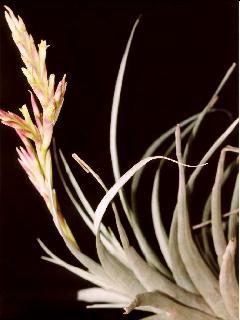
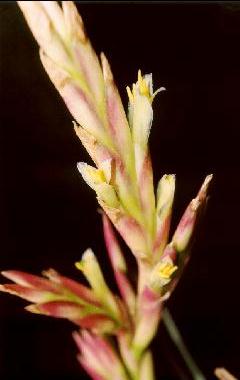
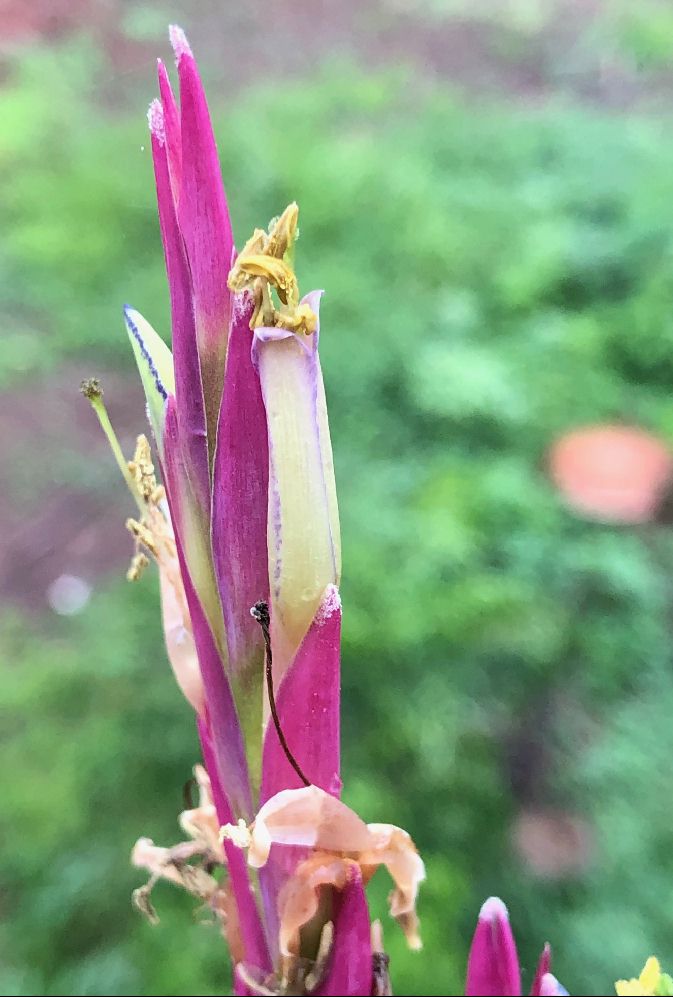
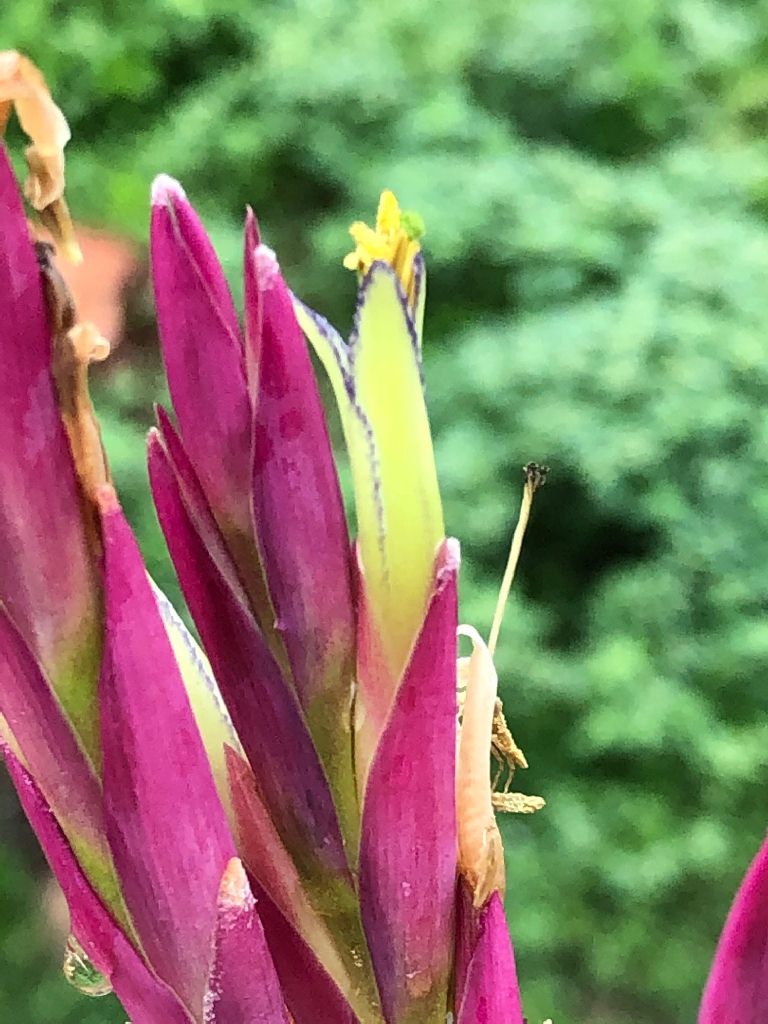
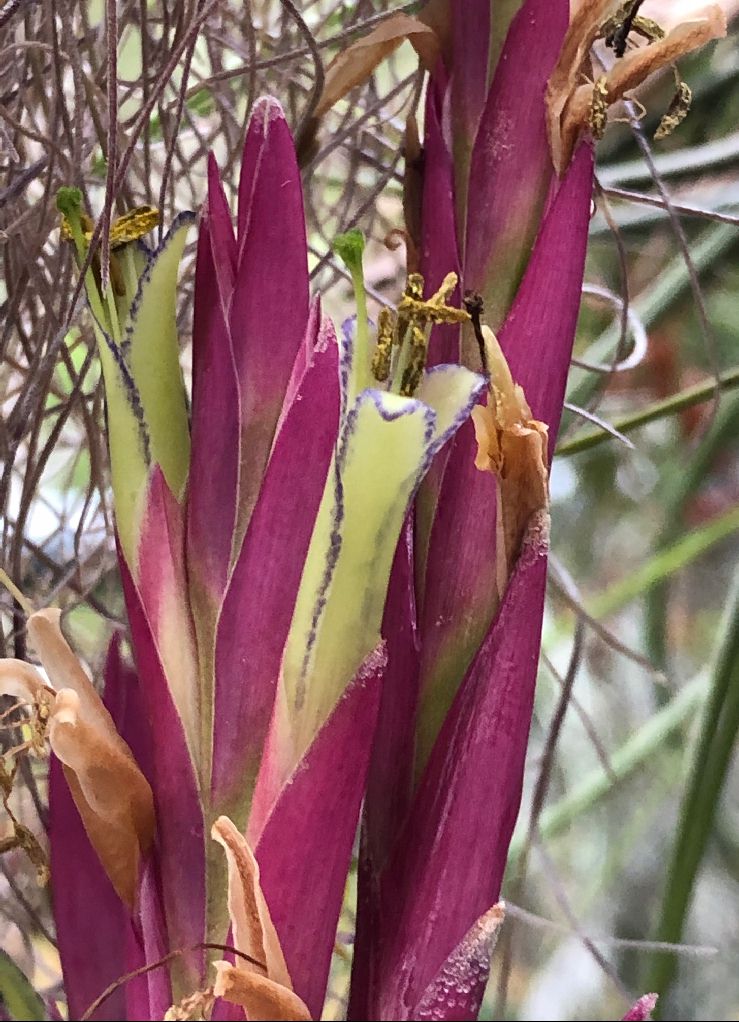
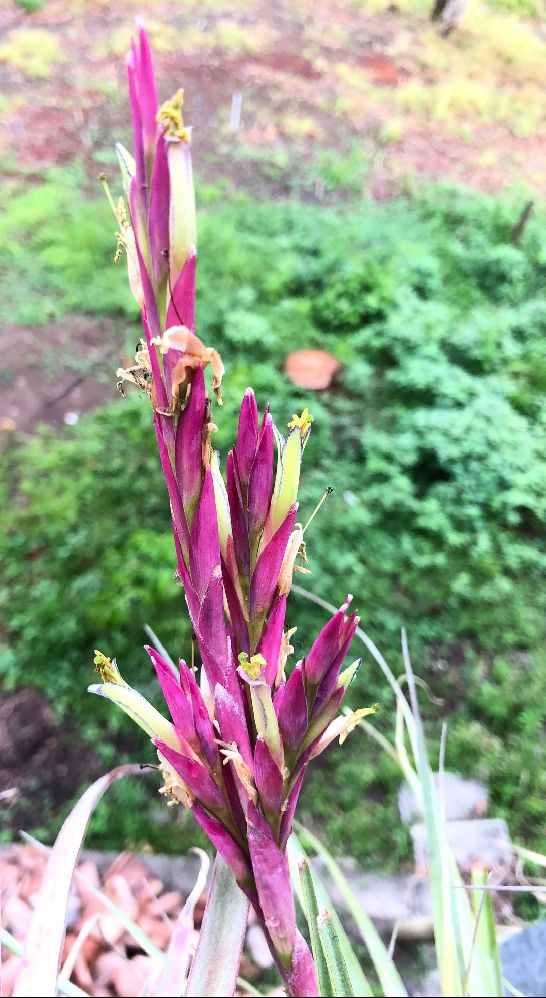
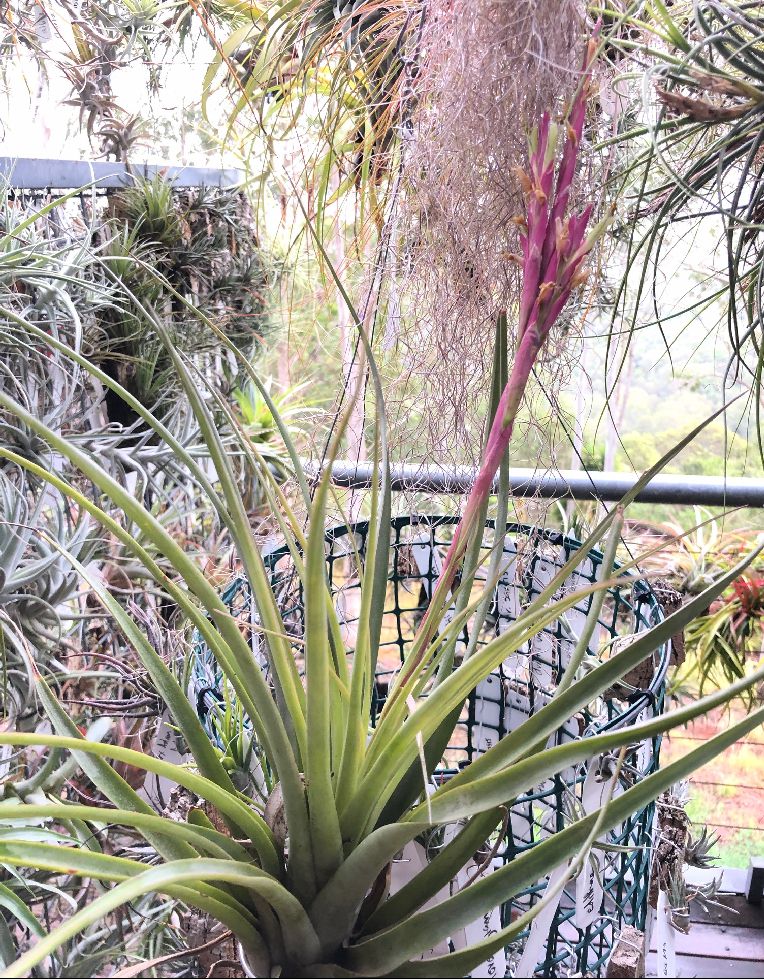
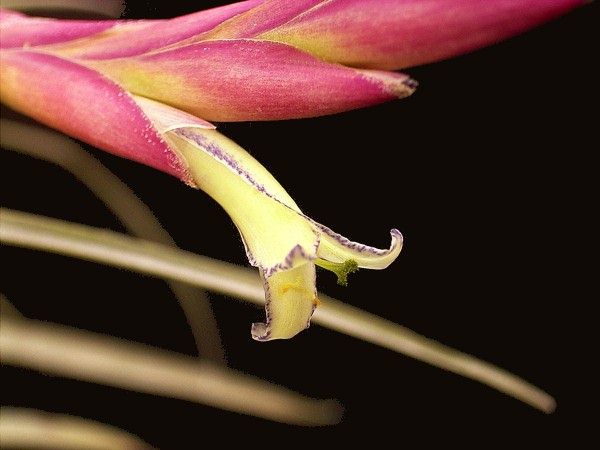
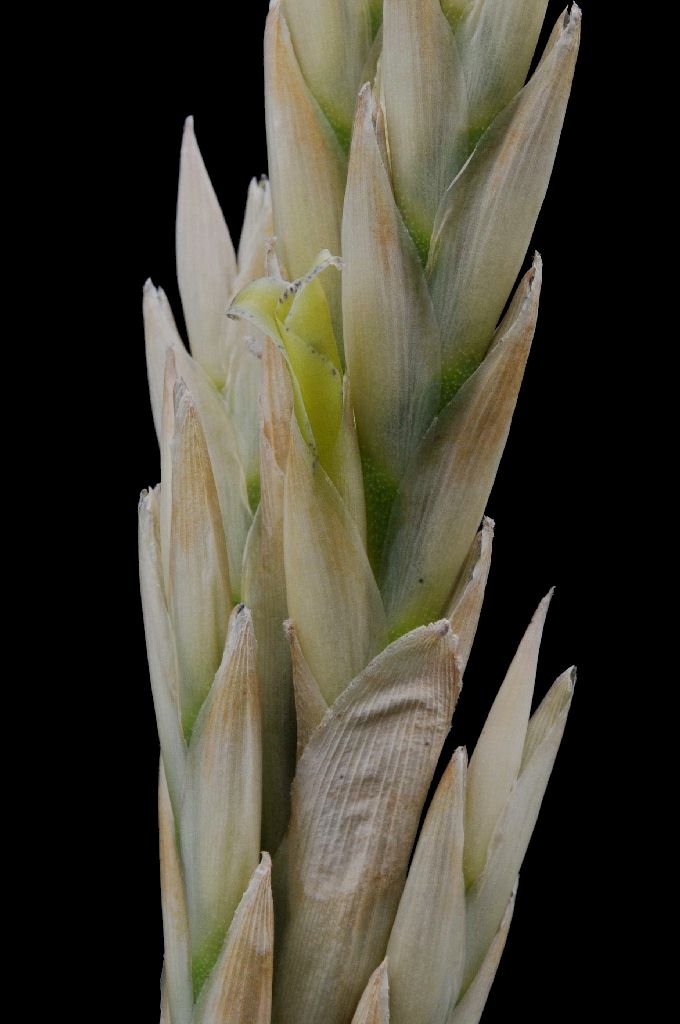
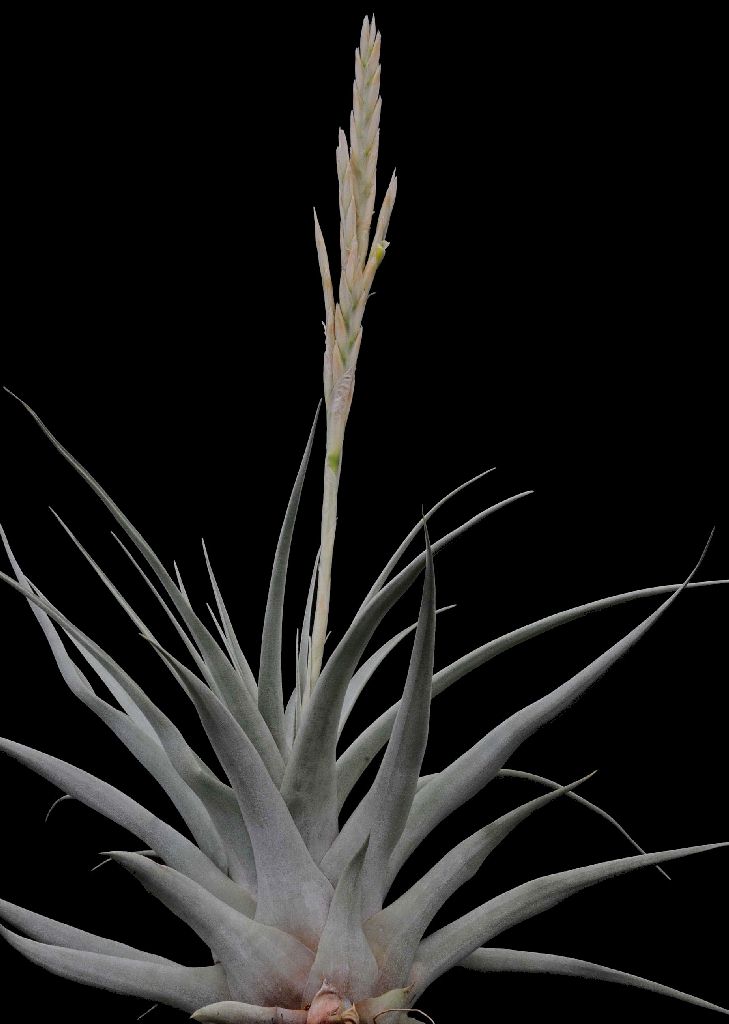
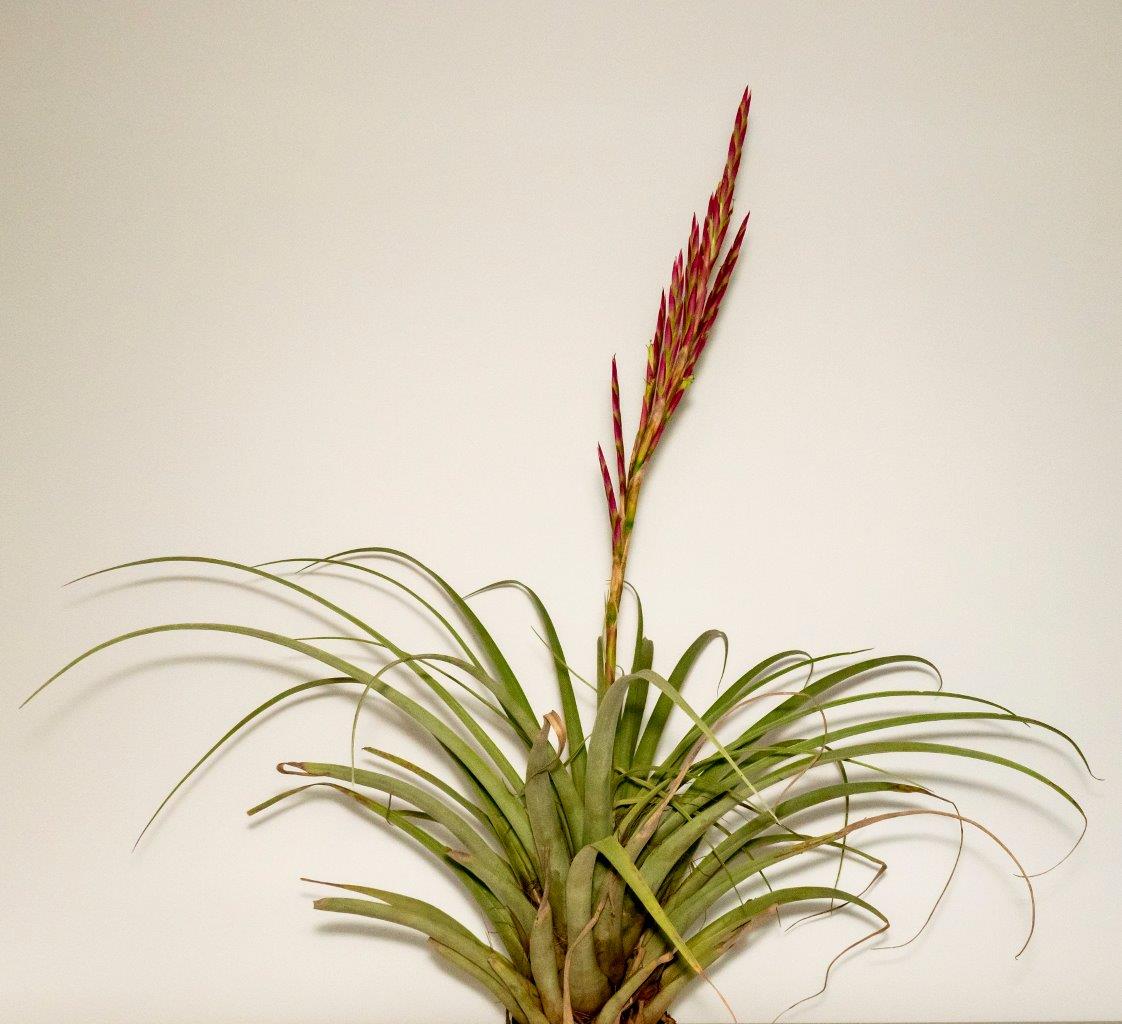
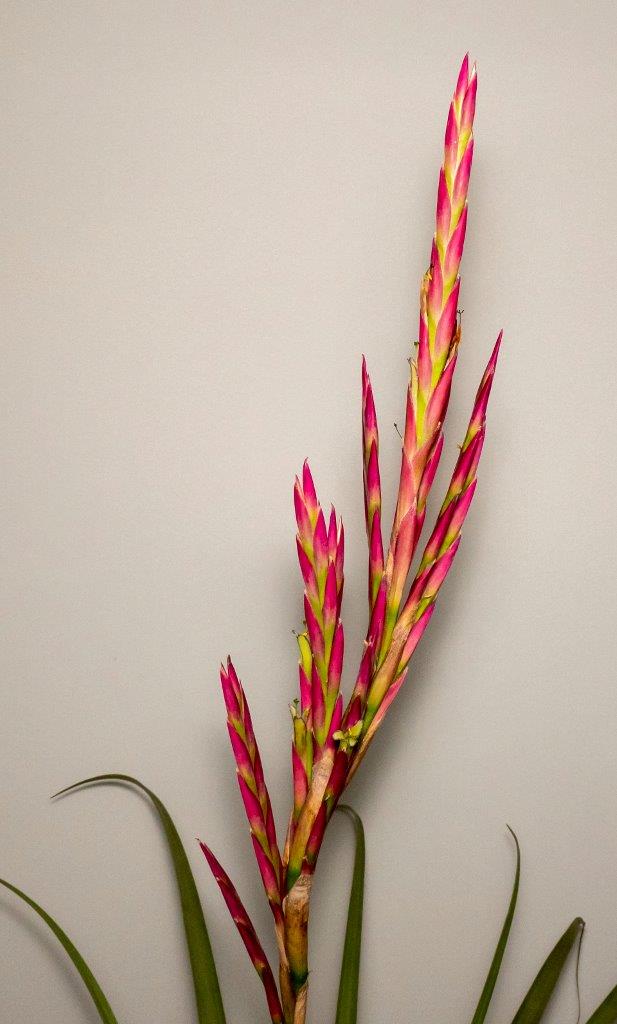
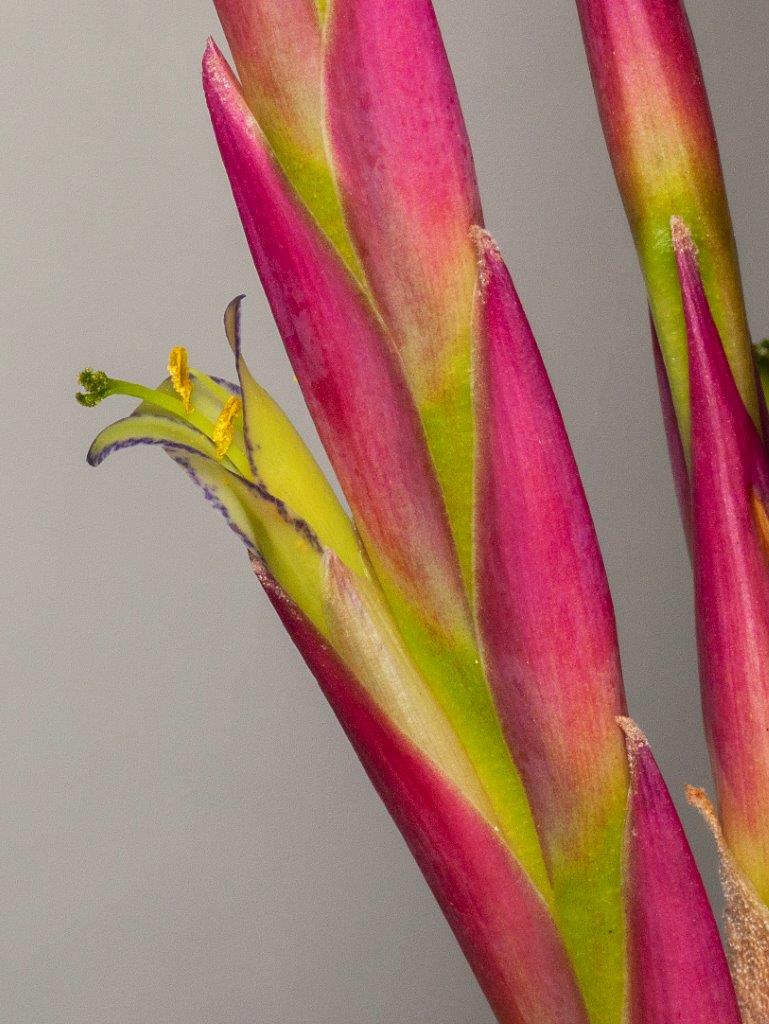
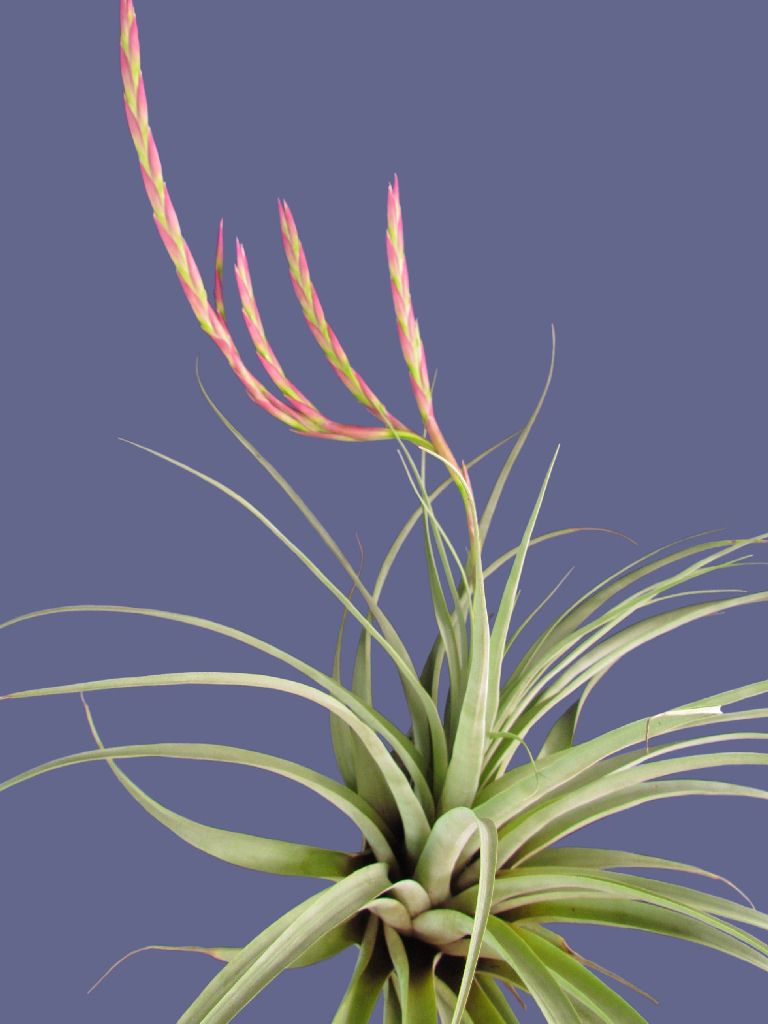
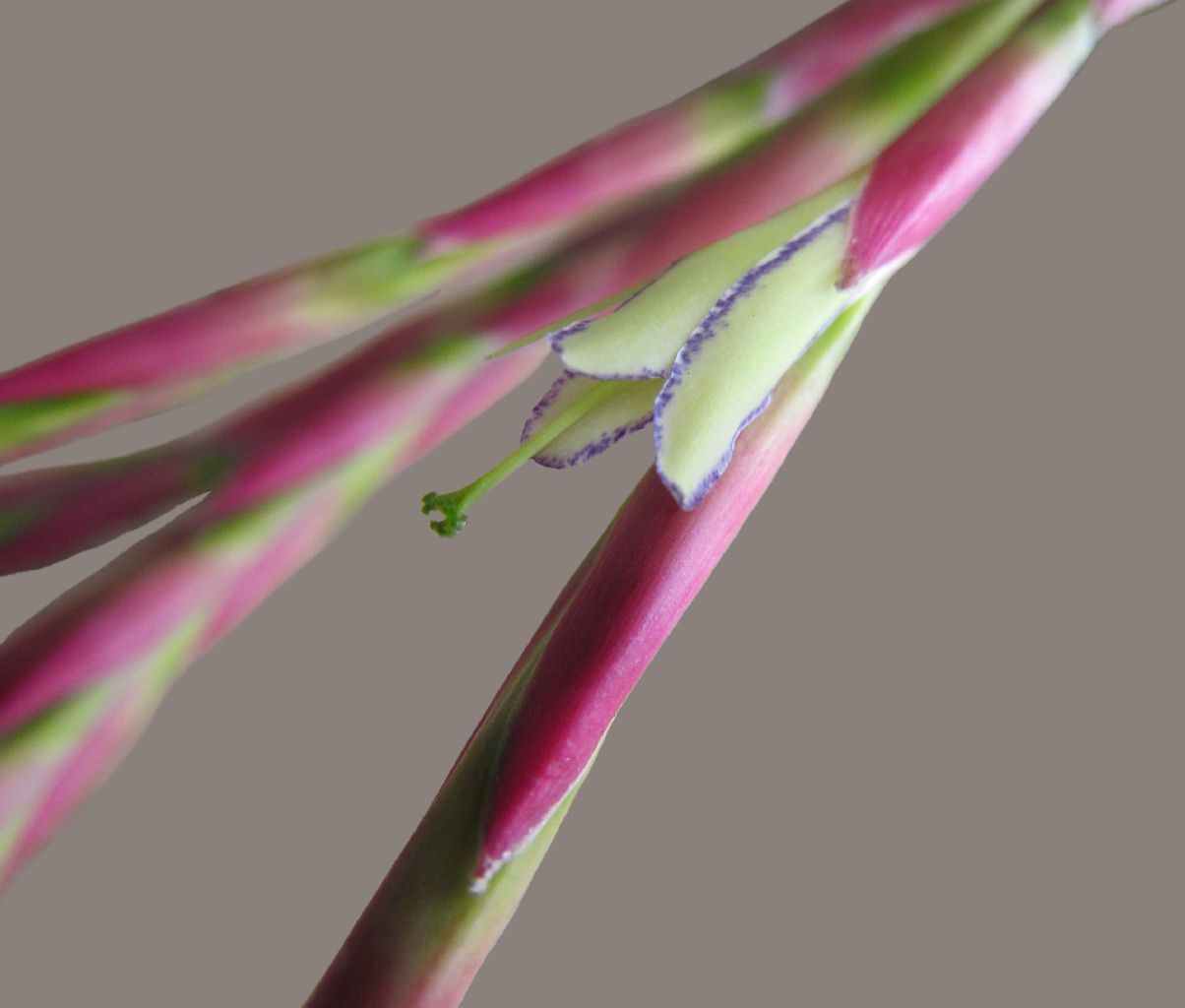
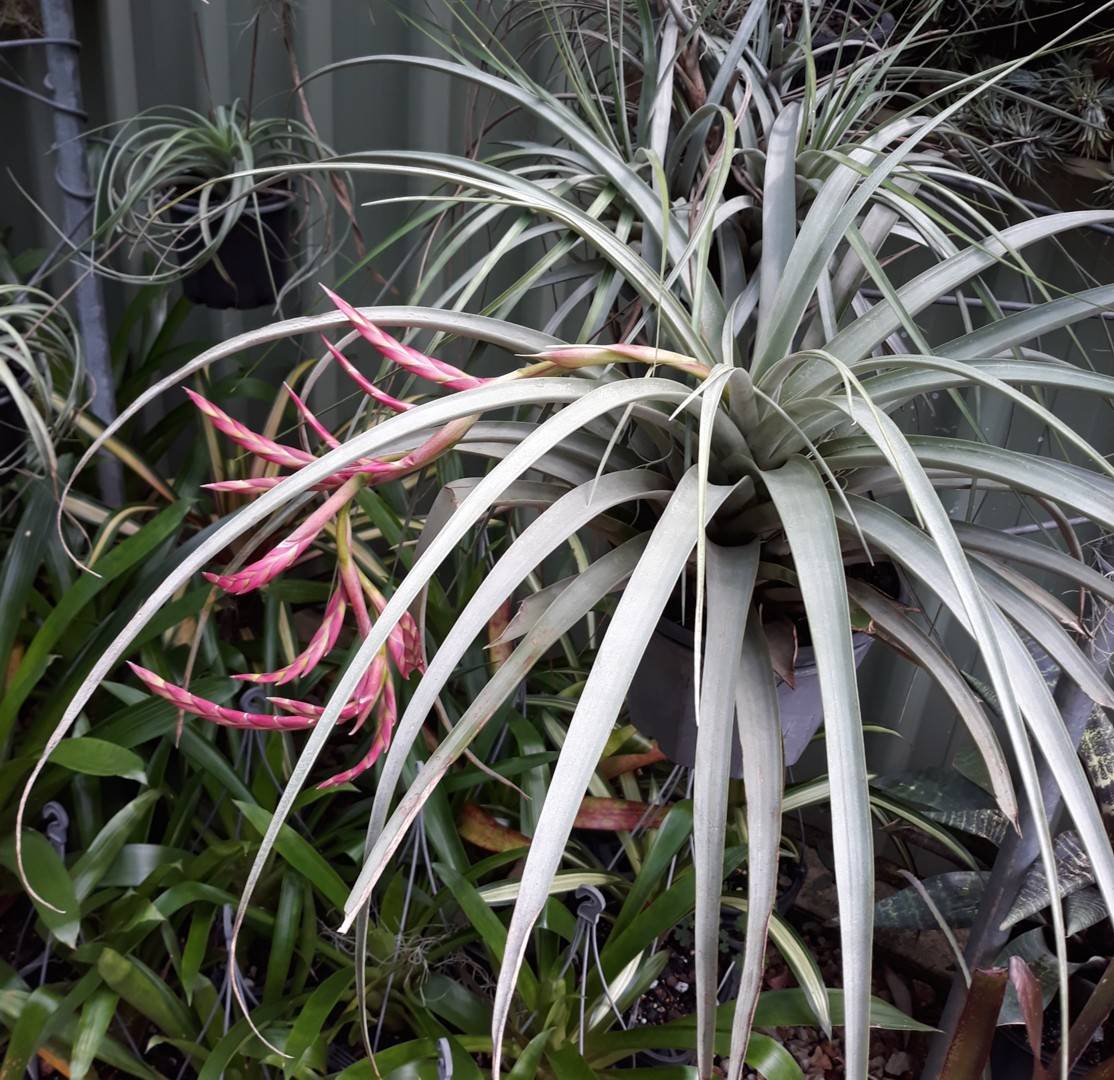

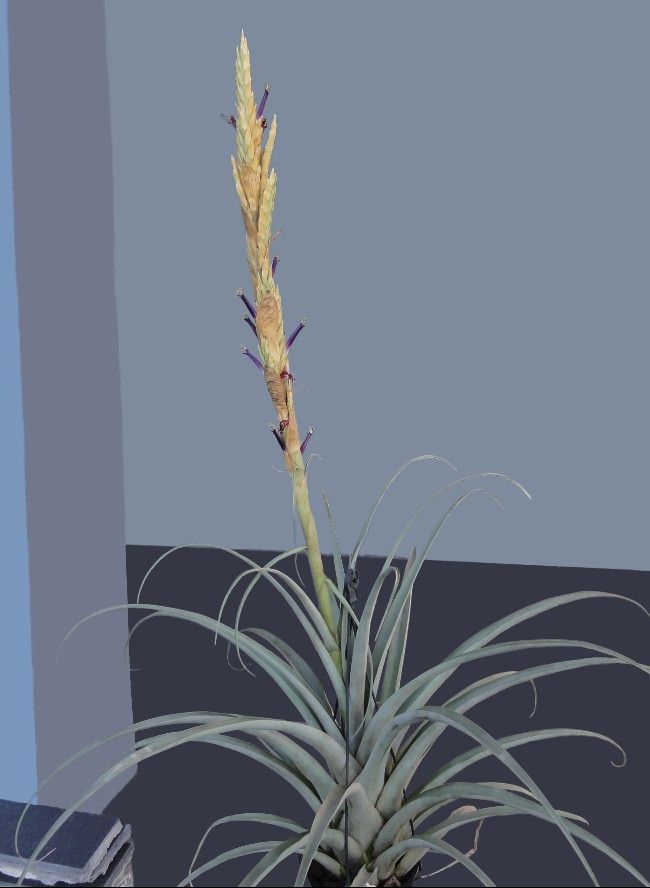
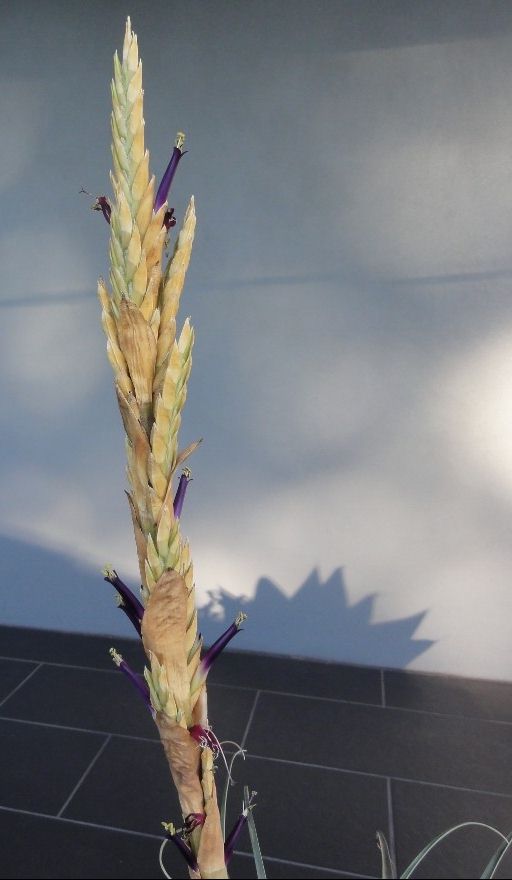
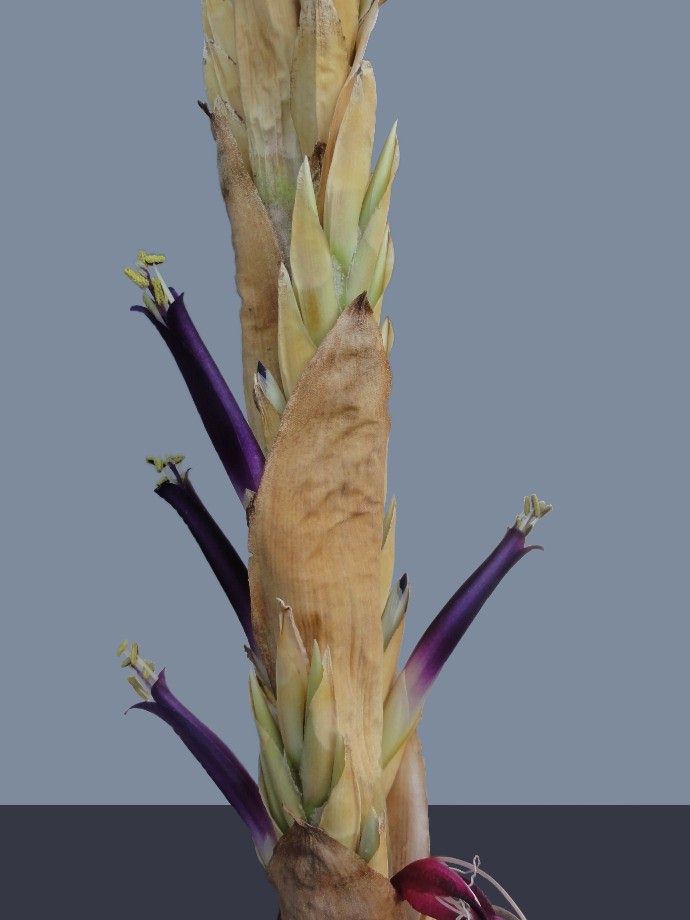
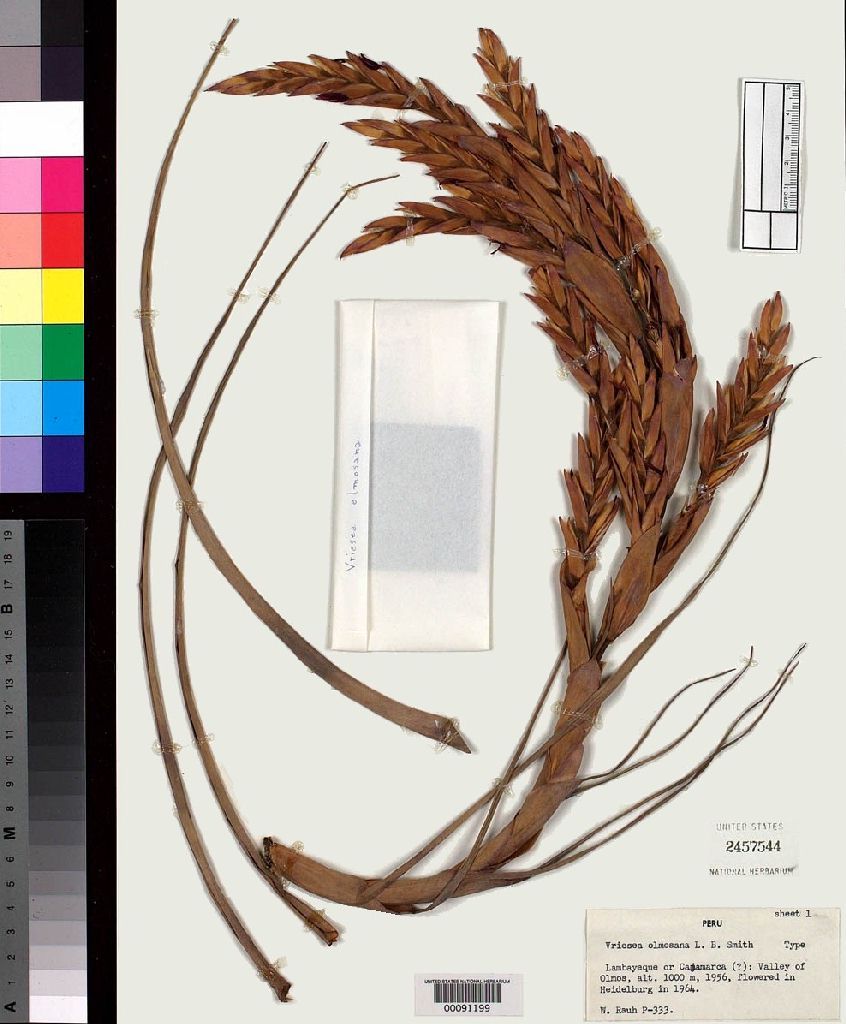
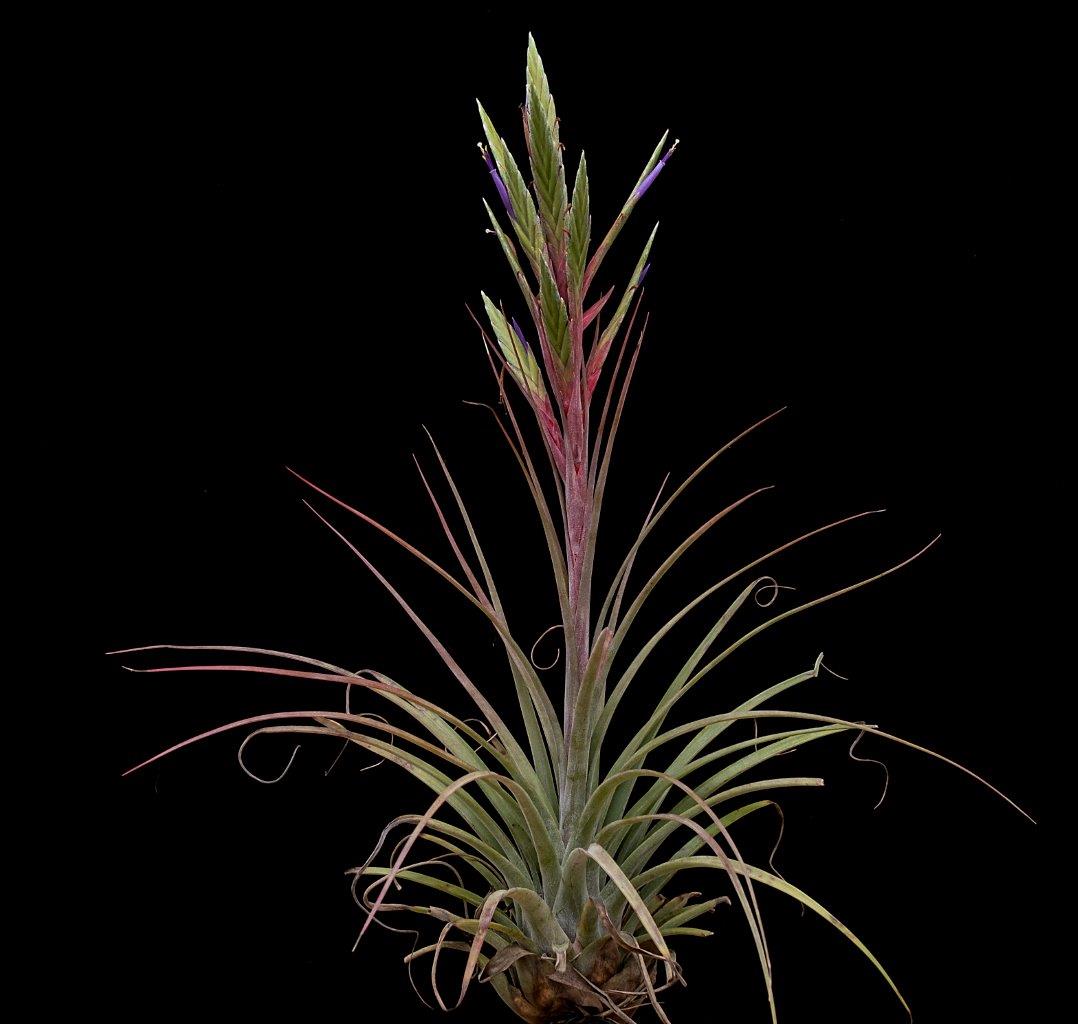
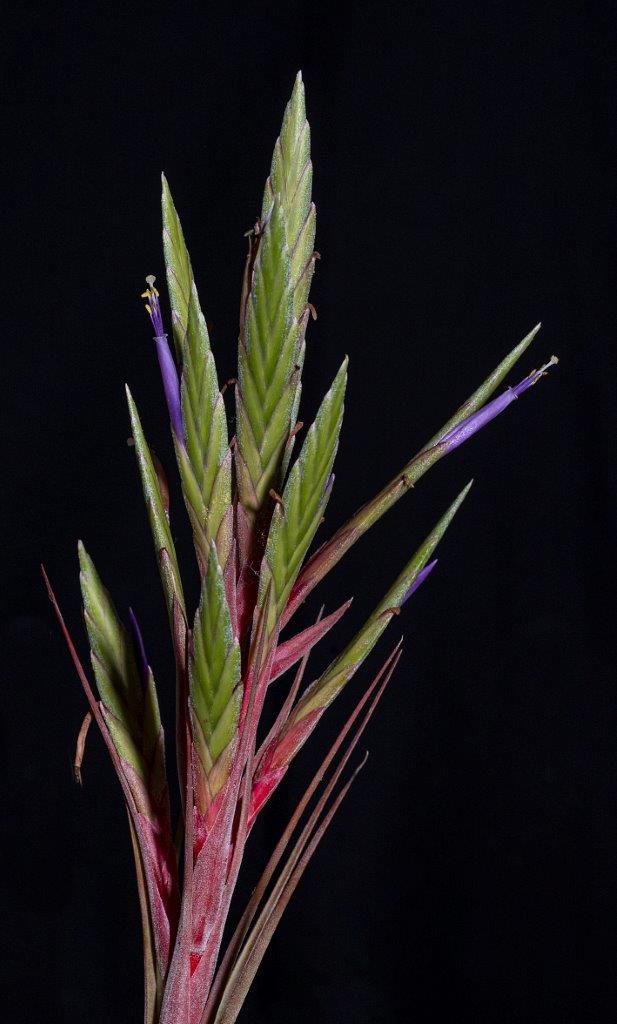
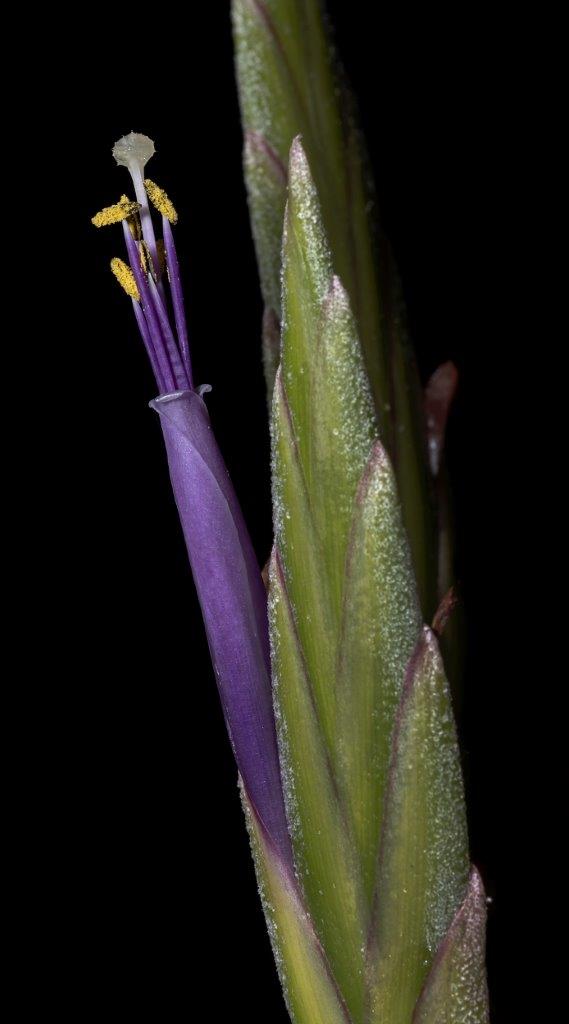
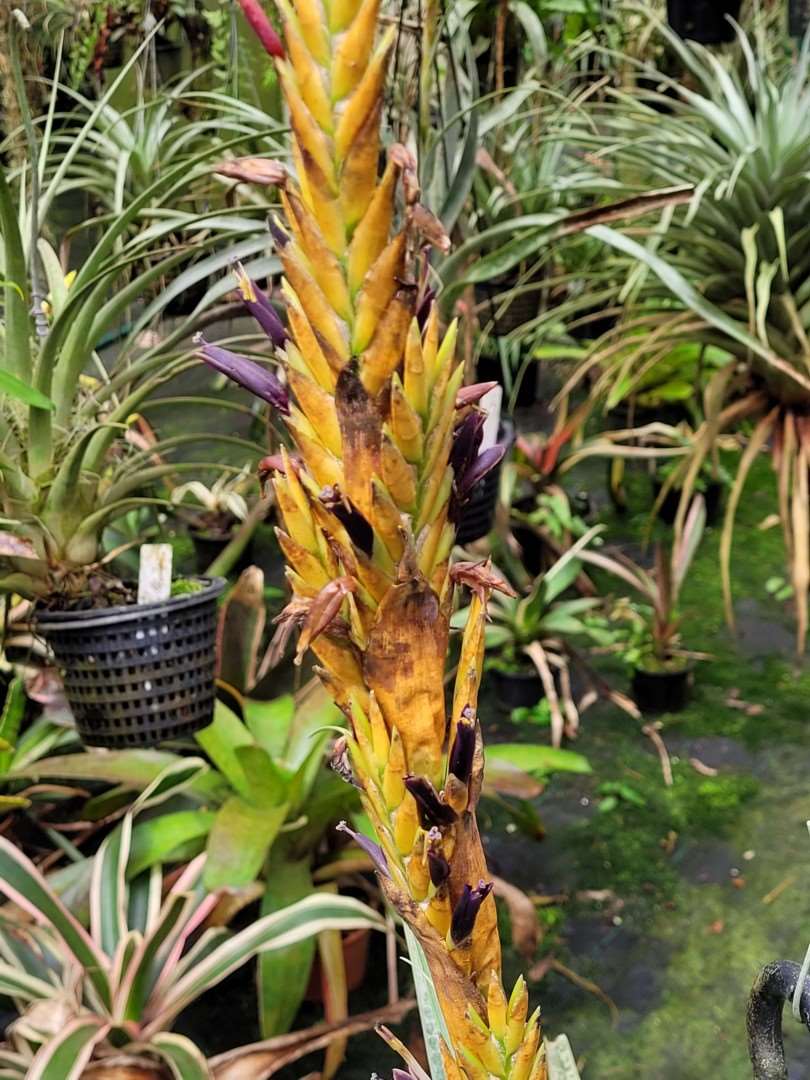
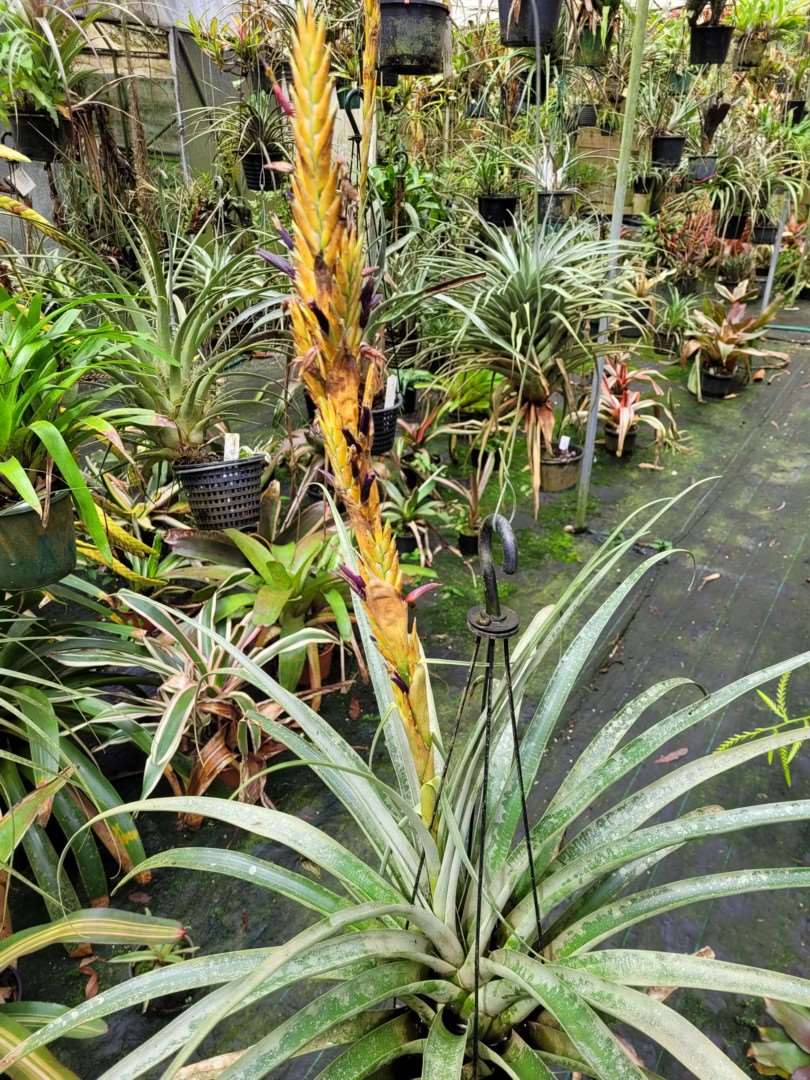
Desc from S&D p1251-2
Plant stemless, flowering to 6 dm long with the inflorescence extended.
Leaves numerous, 5-6 dm long, completely covered with fine appressed cinereous scales;
Sheaths suborbicular, scarcely distinct from the blades, 45 mm wide, ferruginous;
Blades very narrowly triangular, 35 mm wide at base.
Scape decurved, slender, glabrous;
Scape-bracts densely imbricate and completely covering the scape, subfoliaceous with long linear blades.
Inflorescence densely bipinnate, 37 cm long;
Primary bracts broadly ovate, barely exceeding the sterile bracteate bases of the branches, subdensely and obscurely lepidote;
Spikes erect or suberect, the lateral to 14 cm long, the terminal to 18 cm including the sterile base, linear-lanceolate, acute, strongly complanate, 10-12-flowered, dense, gla¬brous;
Rhachis alate.
Floral bracts lanceolate, acute, carinate, 25 mm long, about equaling the sepals, subcoriaceous, nerved and reddish toward apex, yellowish green below; pedicels obscure. Sepals free, lanceolate, broadly acute and apiculate, 23 mm long, ecari¬nate, subcoriaceous;
Petals linear, 35 mm long, bearing 2 large linear-lanceolate acute scales at base, the blades deep blue-violet with a narrow white margin;
Stamens exserted.
Type. Rauh P-333 (holotype US), valley of Olmos, Lambayeque or Cajamarca (?), Peru, flowered in Heidelberg in 1964.
DISTRIBUTION. Known from the type collection only.
Tillandsia olmosana v. pachamamae (Rauh) Grant, Phytologia 75(2): 170-175. 1993
Vriesea olmosana v. pachamamae W Rauh, Trop Subtrop Pflanz. 43: 29-32. 1983
In 1975 when in the hills around the High Pass of Pachamama, 1650 m (Road between Sta. Isabel - Pasaje), we collected with V. andreettae (see page 22), a Vriesea, very close to the so far known in Peru as V. olmosana L. B. Smith, but of smaller growth and with light green petals with blue-violet edges. The plant, that we collected in 1980, has meanwhile flowered in cultivation several times so that we are the opinion, that it was not the same as the Type but merely variety of V. olmosana, that should be named Pachamama after the place of discovery. It is therefore distinguished as follows:
V. olmosana var. olmosana and
V. olmosana var. pachamamae
Vriesea olmosana L. B. Smith, Phytologia 13, 113, 1966, var. olmosana
Plant very robust, flowering to 80 cm high, epiphytic without stolons.
Scape bracts, also the upper ones, long caudate.
Inflorescence erect, (fig. 17, right, left picture) bent, (fig. 17, left) or more rarely hanging, (fig. 17 middle).
Petals blue-violet, with a narrow white seam.
Stamens and style far protruding,( fig. 17, left.)
Holotype: Rauh P 333 (U. S. Herbarium.)
Isotype, HEID.
Range: Epiphytic on trees, 800 m, Ceiba woods, valley of Olmos, Dptm. Lambayeque (North-Peru).
Further collections in North, and central Peru:
Ceiba woods of Olmos, Dptm. Lambayeque, 700 m, (Rauh 24 331 HEID); Chachapoyas, Aug, 67, Dptm. San Martin, (Rauh 20 462 HEID); San Ramon, Dptm. Junin, 1000 m, July 1970, (Rauh 23 694, HEID); between Tingo Maria and Huanuco, Dptm. Huanuco, Aug, 1970 (Rauh 23 964, HEID); mear Oxapampa, 1200 m, Dptm. Junin, July 1971, (Rauh 25 830 HEID).
Vriesea olmosana v. pachamamae W Rauh, var. nova
Unterscheidet sich von V. olmosana var. olmosana in folgenden Merkmalen:
Pf1anze stammlos, mit kurzen Auslaufern, daher gruppenbildend, bluhend bis 60 cm hoch. Blatter zahlreich, eine bis 40 cm hohe und bis 50 cm breite, an der Basis subbulbose Rosette bildend (Abb. 18, links). Blattscheiden ± deutlich abgesetzt, langlich-oval, bis 7 cm lang, 5 cm breit, beiderseits dunkellederbraun beschuppt. Spreiten schmal-3-eckig, bis 30 cm lang, oberhalb der Scheide bis 4 cm breit, sich in eine lange, fadige Spitze verschmalernd, schwach canaliculat, beiderseits dicht angedruckt beschuppt. Inf1oreszenzschaft bis 20 cm lang, kahl, rund, aufrecht (Abb. 18, links; Abb. 18b, links), seltener waagrecht abstehend (Abb. 18a) oder hangend (Abb. 18b, rechts), dicht von den Schaftbrakteen umscheidet, die basalen subfoliat, die oberen nur kurz bespitzt, dem Schaft dicht anliegend (Abb. 18, links), grun bis lebhaft rot, an der Spitze dicht lepidot. Inf1oreszenz locker bipinnat, mit ± 3-7 Ahren (einschliesslich der Endahre), bis 25 cm lang und 4 cm breit. Infloreszenzachse kantig, grun, kahl. Primarbrakteen den oberen Schaftbrakteen ahnlich, viel kurzer als die Ahren, aber langer (bis 4 cm) als der 1 cm lange, gestielte, kantige, sterile Abschnitt, ausgebreitet bis 1,5 cm breit, zugespitzt, oberseits kahl, glanzend, unterseits lepidot, besonders zur braunroten Spitze hin. Seitenahren aufrecht; Endahre bis 13 cm, Seitenahren bis 10 cm lang, z. Z. der Anthese bis 1,5 cm breit, complanat, 6- bis 8-blutig (Abb. 17, rechts; Abb. 18). Ahrenachse kaum sichtbar, grun, kantig, excavat, schwach lepidot. F1ora1e Brakteen aufrecht, carinat, wenig langer als die Sepalen, ± 2,7 cm lang, 1 cm breit, in eine hakige Spitze auslaufend, derb bis membranos, kahl, nur an der Spitze zerstreut lepidot, an der Basis grun, im oberen Abschnitt rotlichbraun. Bluten subsessil, bis 4,5 cm lang. Sepalen, die hinteren undeutlich carinat, bis 25 mm lang, in eine scharfe, rotliche Spitze auslaufend, sonst grun, kahl, bis zum Grunde frei. Petalen schmal-zungenformig, bis 4 cm lang, 5 mm breit, aufrecht, mit leicht zuruck- gebogenen Spitzen, blassgrunlich, mit blau-violettem Saum (Abb. 18, rechts), an der Basis mit 2 langlich-lanzettlichen, 5 mm langen, an der Spitze schwach gezahnten Ligulae. Staubblatter so lang wie die Petalen. Griffel ca. 1 cm herausragend.
Heimat und Verbreitung: Auf Felsen unterhalb der Paghohe Pachamama der Strasse Sta. Isabel - Pasaje in Gesellschaft von V. andreettae und der dort aufgefuhrten Begleitpflanzen, 1650 m, Sudekuador (Prov. Azuay).
Beide Varietaten sind hinsichtlich der Ausbildung der Infloreszenzen variabel. Wahrend in der Originaldiagnose von L. B. Smith angegeben wird, “Infloreszenzachse gekrummt" (s. Abb. 17, links), konnten wir inzwischen Pflanzen mit straff-aufrechten (Abb. 17, rechts) und hangenden Infloreszenzen sammeln (Abb. 17, Mitte). Das Gleiche gilt auch fur die var. pachamamae.
A V. olmosana var. olmosana a characteribus sequentibus differt: planta in partibus omnibus minor, stolonibus brevibus, itaque gregarie crescens. Inflorescentiae plerumque erectae, rarius pendulae; bracteae primariae superiores ecaudatae, tantum acuminatae, spicae breviores tantum usque ad 10 cm longae; petala virescenti-luteae, margine violaceo-limbata; stamina brevia petala non superantia.
Pflanze in allen Teilen kleiner, Bildung kurzer Stolonen, deshalb truppweise auftretend; Infloreszenzen meist straff aufrecht, selten hangend; die nicht caudaten, sondern nur bespitzten oberen Primarbrakteen, die kurzeren, nur bis 10 cm langen Ahren; die grunlich-gelben, am Rande violett gesaumten Petalen und die kurzeren, die Petalen nicht uberragenden Staubblatter.
Holotypus : Rauh 38 139 (Juli 1975), im (HEID).
Weitere Aufsammlungen: Passhohe Pachamama, 1650m, 12.6.80 (Rauh 52 971, HEID.); oberhalb von Sta. Isabel, 1200 m, 12. 6. 80 (B.G.H. 53 370A)
Die meisten Exemplare haben straff-aufrechte Infloreszenzen (Abb. 17, rechts; Abb. 18). Wir konnten aber Exemplare mit waagrecht abstehenden (Abb. 18a), resp. hangenden (Abb. 18b) Infloreszenzen sammeln. Da sie alle hinsichtlich des Blutenbaues und der Petalenfarbe ubereinstimmen, sind sie lediglich als abweichende Formen zu betrachten.
V. olmosana var. pachamamae
Plant stemless, with short stolons, making clumps, flowering to 60cm high..
Leaves numerous, making a 40cm high, 50cm wide rosette which is sub-bulbose at base.
Leaf sheath more or less distinct, longish oval, to 7cm long, 5cm wide, both sides with dark leathery brown scales.
Leaf blade narrow triangular, to 30cm long, 4cm wide next to sheath, narrowing to a long filiform tip, weakly channelled, both sides with dense appressed scales.
Scape to 20cm long, naked, round, erect, rarely horizontal or hanging, densely covered by the scape bracts.
Scape bracts leaflike at the bottom, towards the top short tipped, adjacent to the stem, green to lively red, densely lepidote at the tip.
Inflorescence laxly bipinnate, with about 3 – 7 spikes (including the top spike), to 25cm long, 4cm wide, Inflorescence rhachis edged, green, naked.
Primary bract similar to upper scape bracts, much shorter than the spike but longer (to 4cm) than the 1cm long, stemmed, edged sterile section, at its widest 1.5cm wide, acuminate, top side naked, shiny, underneath lepidote, particularly towards the brownish-red tip.
Side spike erect, top spike to 13cm long, side spikes to 10cm long, to 1.5cm wide at anthesis, complanate, 6 – 8 flowered, Spike rhachis hardly visible, green, edged, excavated, weakly lepidote.
Flower bract erect, keeled, a little longer than the sepal, ca. 2.7cm long, 1cm wide, tapering to a hooked tip, robust to membranous, naked, scarcely scattered lepidote at tip, the bottom green with the upper portion reddish-brown.
Flower subsessile, to 4.5cm long.
Sepal the posterior ones indistinctly keeled, to 25mm long, tapering to a sharp reddish tip, otherwise green, naked, free.
Petal thin tongue shaped, to 4cm long, 5mm wide, erect, with lightly reflexed tips, pale greenish, with blue-violet edges, the base with 2 longish lancelike, 5mm long, weakly serrated tip, appendages.
Stamen as long as the petal.
Style overhangs by about 1cm.
Habitat on rocks, below the high pass Pachamama on the road between Santa Isabel and Pasaje in the same area as V. andreettae, at 1650m. S Ecuador (Prov Azuay)
Holotype Rauh 38 139 (July 1975) in HEID
Other collections High pass Pachamamae 1650m, 12 June 1980 (Rauh 52 971 HEID), near Sta Isabel, 1200m, 12 June 1980 (BH 53 370A)
Differs from Type in
1. - Plant is smaller.
2. - Stolons shorter.
3. - Forms clumps.
4. - Inflorescence mostly erect, rarely pendulous.
5. - Primary bracts not keeled, barely acuminate.
6. - Spikes shorter, barely 10cm long.
7. - Petals greenish yellow edged violet.
8. - Stamens not exceeding the petals.
Both varieties are variable regarding the understanding of the inflorescence. In the original diagnosis by L. B. Smith we see, “Scape decurved " (See Fig. 17, left), we could have plants with straight erect (fig.17, right), and hanging inflorescence,( fig. 17 middle). The same applies for var. pachamamae.
Most specimens have straight erect inflorescences (fig. 17, right; fig. 18). We could have specimens with horizontal spreading, (fig. 18a,) and hanging inflorescences,( fig. 18b). Because all have the same floral origins and petal colour, they are to be viewed merely as deviant forms.